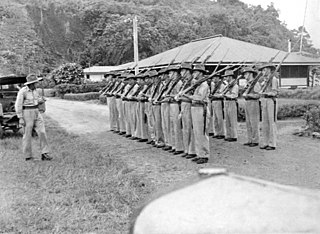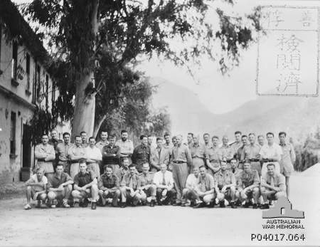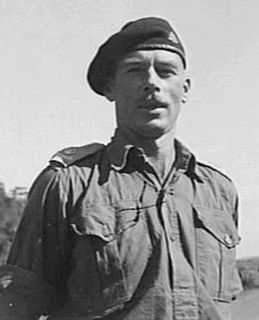The name commando has been applied to a variety of Australian special forces and light infantry units that have been formed since 1941–42. The first Australian "commando" units were formed during the Second World War, where they mainly performed reconnaissance and long-range patrol roles during Australia's campaigns in New Guinea and Borneo, although other units such as M and Z Special Units performed more clandestine roles. These units were disbanded following the end of the war; however, in the 1950s it was realised that there was a need for such units again in the Australian forces. Today, the Australian Army possesses a number of units that perform more conventional direct-action type commando roles, as well as counter-terrorism response, long-range patrolling, and clandestine deep-penetration operations.

The Battle of Wau, 29 January – 4 February 1943, was a battle in the New Guinea campaign of World War II. Forces of the Empire of Japan sailed from Rabaul and crossed the Solomon Sea and, despite Allied air attacks, successfully reached Lae, where they disembarked. Japanese troops then advanced overland on Wau, an Australian base that potentially threatened the Japanese positions at Salamaua and Lae. A race developed between the Japanese moving overland, hampered by the terrain, and the Australians, moving by air, hampered by the weather. By the time the Japanese reached the Wau area after a trek over the mountains, the Australian defenders had been greatly reinforced by air. In the battle that followed, despite achieving tactical surprise by approaching from an unexpected direction, the Japanese attackers were unable to capture Wau.

The Salamaua–Lae campaign was a series of actions in the New Guinea campaign of World War II. Australian and United States forces sought to capture two major Japanese bases, one in the town of Lae, and another one at Salamaua. The campaign to take the Salamaua and Lae area began after the successful defence of Wau in late January, which was followed up by an Australian advance towards Mubo as the Japanese troops that had attacked Wau withdrew to positions around Mubo. A series of actions followed over the course of several months as the Australian 3rd Division advanced north-east towards Salamaua. After an amphibious landing at Nassau Bay, the Australians were reinforced by a US regimental combat team, which subsequently advanced north up the coast.
The 2/4th Commando Squadron was one of 12 independent companies and commando squadrons raised by the Australian Army during the Second World War. Raised in August 1941, it was disbanded not long after due to conceptual problems, but it was quickly reformed following the entry of Japan into the war in December 1941. After a period of about six months performing garrison duties in northern Australia, the 2/4th was deployed to Portuguese Timor to reinforce the other Australian units already waging a guerilla war on the island. After a brief campaign the 2/4th was returned to Australia and from there it went on to serve in New Guinea in 1943, taking part in the Salamaua-Lae campaign attached to the 9th Division. Later, the squadron was involved in one of the last campaigns of the war when it landed on Tarakan Island in May 1945 and took part in the Borneo campaign. Following the end of hostilities, the 2/4th returned to Australia and was disbanded at Ingleburn, New South Wales, on 8 January 1946.

The New Guinea Volunteer Rifles (NGVR) was an infantry battalion of the Australian Army. It was initially raised as a unit of the Militia from white Australian and European expatriates in New Guinea upon the outbreak of the Second World War in 1939, before being activated for full-time service following the Japanese landings in early 1942. NGVR personnel then helped rescue survivors of Lark Force from Rabaul in February and March 1942. Between March and May, the NGVR monitored the Japanese bases which had been established in the Huon Gulf region, being the only Allied force in the area until the arrival of Kanga Force at Wau in May. The battalion subsequently established observation posts overlooking the main approaches and reported on Japanese movements.

Kanga Force was the name given to a composite ad hoc formation of the Australian Army that served in New Guinea during World War II. Commanded by Major Norman Fleay, it was formed on 23 April 1942. Made up of elements from the 1st and 2/5th Independent Companies and the New Guinea Volunteer Rifles (NGVR), Kanga Force conducted a number of small scale raids and reconnaissance operations around Lae and Salamaua before it was disbanded and the individual units became part of the Australian 3rd Division in 1943.

The 2/6th Commando Squadron was one of 12 independent companies or commando squadrons raised by the Australian Army during the Second World War. Raised in May 1942 as the 2/6th Independent Company, the 2/6th's main role was to conduct irregular type warfare including small scale raiding, sabotage, long-range patrolling and reconnaissance operations rather than the traditional commando type direct action operations. As such, for the most part the unit conducted operations in small groups operating inside enemy territory, or out in front of larger friendly forces. Between 1942 and 1945, the 2/6th undertook four major campaigns during the war—Kokoda, Buna, Markham–Ramu and Borneo—and was involved in arguably one of the most spectacular small unit actions of the war during the Battle of Kaiapit. The unit was disbanded in January 1946, following the cessation of hostilities in the Pacific.

The 1st Independent Company was one of twelve independent or commando companies raised by the Australian Army for service in World War II. Raised in 1941, the 1st Independent Company served in New Ireland, New Britain and New Guinea in the early stages of the war in the Pacific, taking part in a major commando raid on Salamaua in June 1942. Having lost a large number of men captured by the enemy as well as a number of battle casualties, the company was withdrawn from New Britain later in 1942. The company was subsequently disbanded, with its surviving members being transferred to other commando units, and it was never re-raised.

The Invasion of Salamaua–Lae, called Operation SR by the Japanese, was an operation by Imperial Japanese forces to occupy the Salamaua–Lae area in the Territory of New Guinea during the Pacific campaign of World War II. The Japanese invaded and occupied the location in order to construct an airfield and establish a base to cover and support the advance of Japanese forces into the eastern New Guinea and Coral Sea areas. The small Australian garrison in the area withdrew as the Japanese landed and did not contest the invasion.

The 2/2nd Commando Squadron was one of 12 independent companies or commando squadrons raised by the Australian Army for service during World War II. The 2/2nd served in Timor, New Guinea and New Britain during World War II, taking part in the Battle of Timor in June 1942 as part of Sparrow Force. Following the capture of the island, the company was withdrawn in December 1942 and returned to Australia, later taking part in operations in New Guinea in 1943–1944 and then on New Britain in 1945.
The 2/3rd Commando Squadron was one of twelve independent or commando companies and squadrons formed by the Australian Army for service during World War II. Raised in October 1941 as the 2/3rd Independent Company, it served in New Caledonia and New Guinea before being amalgamated into the 2/7th Cavalry Commando Regiment and adopting the name 2/3rd Commando Squadron in 1943. After this, the squadron did not see action again until 1945, when it participated in the Borneo campaign. Throughout the course of the war, the 2/3rd lost 69 members killed in action. No battle honours were awarded to the unit, although it participated in a number of notable engagements in these campaigns and its members received numerous decorations for their service. Following the end of hostilities in the Pacific, the unit was disbanded in early 1946, upon their return to Australia.
The 2/7th Commando Company was one of 12 independent companies or commando squadrons raised by the Australian Army during the Second World War. Raised in May 1942, as the 2/7th Independent Company, the 2/7th served in New Guinea in 1943 during the Salamaua–Lae campaign before being redesignated as the 2/7th Commando Squadron when it was amalgamated with two other commando squadrons to become part of the 2/6th Cavalry (Commando) Regiment. Later at the end of 1944, it was sent to New Guinea again, where it took part in the Aitape–Wewak campaign. Following the end of the war, the squadron was returned to Australia and disbanded early in 1946.
Lieutenant Colonel Gordon Grimsley King, DSO was an officer of the Australian Army during the Second World War.
The Raid on Salamaua was a conducted by Australian commandoes during the New Guinea campaign of World War II on 28 June 1942. It has been called the first offensive action on land against the Japanese in World War II. The raid was undertaken by 2/5th Commando Squadron (Australia) under the command of Captain Norman Winning. According to one account, "The raid has been acclaimed as a copybook action for its diligent scouting, meticulous planning and audacious, multi-pronged attack against an enemy force 10 times the attackers' strength. All without loss of life."

Norman Isaac Winning, was a British-Australian soldier best known for leading the Salamaua Raid during World War II. He migrated to Java as a young man to work on a plantation. After the outbreak of war, he enlisted in the Australian forces in 1940 and fought against the Japanese in the New Guinea and Bougainville campaigns. After the war, he returned to Java, where he continued to manage one of the plantations. He was murdered there by anti-European rebels in 1950.
The Raid on Heath's Farm was conducted by Australian commandoes in New Guinea on 1 July 1942. It followed the Salamaua Raid and took place 7 miles (11 km) outside of Lae. 44 Japanese were killed.
The Raid on Mubo was a raid by Australian commandos on the Japanese base at Mubo in New Guinea in World War II conducted on 1 October 1942. A party of 60 soldiers from the 2/5th Commando Squadron (Australia) under Norman Winning attacked the Japanese base. It was estimated up to 50 Japanese were killed.

The Battle of Mubo was a series of actions in the Mubo area of the Territory of New Guinea between Australian and Japanese forces which took place between 22 April and 14 July 1943, during World War II. The battle formed part of the wider Salamaua–Lae campaign, and was fought in the early stages of the campaign. The battle followed the successful defence of the airfield around Wau by the Australians in late January 1943, after the Japanese had attempted to infiltrate the Australian positions with two infantry battalions.

The Battle of Bobdubi was a series of actions fought in the Salamaua area of the Territory of New Guinea between Australian and Japanese forces which took place from 22 April to 19 August 1943, during World War II. Part of the Allied advance on Salamaua, the battle was fought in conjunction with several other actions in the region as the Allies attempted to draw Japanese attention away from Lae, where they launched seaborne landings in mid-September 1943 in conjunction with airborne landings around Nadzab. The initial phase of the fighting around Bobdubi was characterised mainly by small unit harassment and reconnaissance operations, while the second phase saw the capture of a number of Japanese defensive positions in locations dubbed "Old Vickers", "Timbered Knoll" and the "Coconuts".

The Battle of Mount Tambu was a series of actions fought in the Salamaua area of the Territory of New Guinea between Allied and Japanese forces, which took place between 16 July and 18 August 1943, during World War II. The battle formed part of the wider Salamaua–Lae campaign and was fought in the final stages of the campaign, which had seen a combined Australian and US force advance from Wau towards Salamaua following the repulse of the Japanese attack on Wau in late January and early February 1943. After several frontal assaults on the position by Australian and US infantrymen were rebuffed by determined Japanese defenders, an indirect approach was sought and flanking moves were undertaken to cut off the Japanese supply route along the Komiatum Track. This succeeded in eventually forcing the Japanese off the position as they withdrew to avoid encirclement.

















